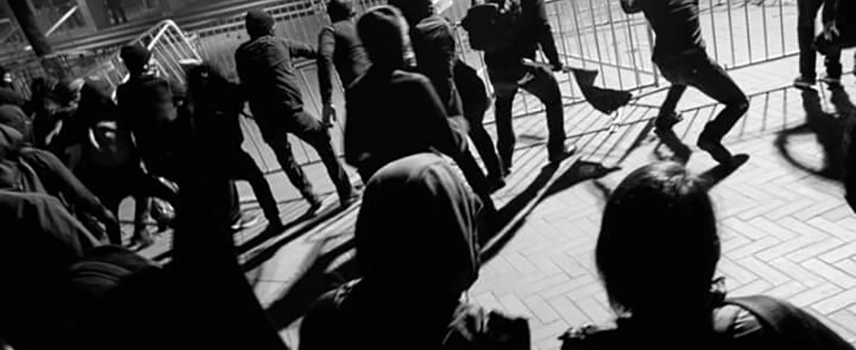Use of Force as a Bodyguard
“If you use Force as a Bodyguard, be prepared to defend your decision making in court”
by Sat Rayit & Alex Bomberg | updated 29th July 2024

Use of Force as a Professional Bodyguard - do you know the law and know your rights?
Many of us who work in the Executive Protection industry are seasoned professionals with an array of backgrounds. A common delusion is that we know it all because we have either been in the industry for a long time, and/or been trained in a martial art of some discipline, so can handle ourselves.
All of the above is great and hats off to all that are in the above bracket. However, with the ever-changing environments and evolvement of criminal activity in the last few years, it is imperative we constantly revisit our personal use of force assessments, as well as third-party protective ones.
This blog article is aimed at bodyguards to highlight considerations used in decision-making, in relation to use of force and its relevance, as this is sometimes overlooked.
The questions we would like to address:
- What was your decision-making process?
- What force is appropriate?
- If you use force as a Bodyguard, have you failed?
We all know that you will have a few short seconds to react to a threat, but, should you be asked to justify your actions in court - could you do that?
When physical restraint goes wrong – recent case history
There are two recent and sad cases in the UK courts that highlight both the importance of training and in making the right decisions when it comes to the use of physical restraint by security professionals.
Victim: James Etherington
On the 25th November 2017, 24-year-old James Etherington was ejected from the Bijou nightclub. During this ejection, it is alleged that Mr Etherington was Mr Spencer, an SIA licensed doorman, used “an inappropriate headlock or neck-hold” to force Mr Etherington out of the club and he was rendered "unconscious or almost unconscious" before the defendant let go of him outside the entrance.
Mr Etherington died ten days later. A pathologist had indicated that the strongest possibility was Mr Etherington was rendered unconscious or near to it by the application of the headlock.
"The prosecution's case is that his death was the result of the defendant's unlawful actions that night."
In a police interview, Mr Spencer admitted getting him in "a bit of a headlock" but denied holding him round the neck. He had just "let him go" and didn't know if Mr Etherington had tripped, he told police.
Victim: Jason Gregory
On the 6th of May 2017, in Southampton, 44-year-old Jason Gregory became involved in an altercation near a night club. Security staff restrained Mr Gregory and he had a cardiac arrest.
According to the senior coroner, Grahame Short, Mr Gregory's cardiac arrest was likely to have been caused by the "combined and delayed effects" of neck compression, Mr Gregory having been “held around his neck for part of the time”.
Mr Gregory resisting the restraint and both alcohol and drugs intoxication were also “combined factors”.
The senior coroner, Grahame Short recorded that Mr Gregory had been "restrained in an inappropriate manner".
Jason Gregory died four days after the incident.
Both the above cases prompted the SIA to release the case study “a fatal restraint” that is based on the Jason Gregory incident.

Know the law!
In the UK, there are very specific and fair laws regarding the use of force.
Common law recognises that people may lawfully use force in certain circumstances, such as self-defence or to protect others. The force used must be reasonable and proportionate to the desired outcome. This means that the force used should be no more than necessary to achieve the desired result.
Here are some examples of when reasonable force may be used:
Self-defenceUsing force to protect yourself from an attack, such as using an object as a weapon
Protecting othersUsing force to protect others from an attack, such as stopping an intruder by tackling them to the ground
Preventing crimeUsing force to prevent crime, such as assisting in the lawful arrest of an offender or suspected offender
Pre-emptive Strike
A person can strike someone in self-defence in the UK if you use reasonable force in the circumstances and genuinely believe it's necessary. The law on self-defence is based on a combination of common law and statute. When assessing whether force was reasonable, prosecutors will consider things like:
NecessityWas force needed at all? For example, if someone shouts at you for being in the way, punching them in the face is probably not necessary.
ProportionalityWas the force proportionate to the threat? For example, stabbing someone who shoves you is likely to be considered unreasonable.
Act within reasonWhen using force, security operatives should consider the following guidelines:
- Use the minimum amount of force necessary
- Use force in proportion to the seriousness of the evil being prevented
- Use force in good faith, not maliciously
What force is appropriate?
In terms of actual physical force applied in Executive Protection, there are subdivisions, such as: What part of Executive Protection are you performing? As a Media Close Protection Team, you may have to use your knowledge skills to cordon off areas or routes, using methods which may include: blocking with physical presence, hand and arm movements and also verbal requests.
There will always be that individual who wants to cause a problem – these will normally try on purpose to ram through, especially in public areas. Here, you will have to apply those blocking techniques, along with ushering the principal to the side or a compressed route.
Most Corporate Executive Protection is more covert, as they don’t want to attract attention. As always, it is the transit points that are the vulnerable areas where the physical aspects may be required. This is where third-party protection must consider the ‘Cooper colour codes’, not only for you and your team, but also for the principal whist under your protection.
Other areas of Executive Protection also include watching for petty criminals (pickpockets), both domestically and overseas - sometimes this converts into Protective Surveillance. Here, you may elect to go in ‘hands-on’, if you see a gang or person that physically targets and engages your principal. A sense of ‘profile offender behaviour and behavioural detection’ comes into play.
A perfect example of going ‘hands-on’, is a pickpocket going for your principal’s handbag or wallet. Yes, I hear you all say: “I would brief my client and principal” – correct, as most do. However, the reality of them putting this into practice is really quite different.
In the above scenario, based on the situation, you may go into a push, grab, hold, move (on either your principal or assailant, as your primary role is to be the buffer and not to ‘beat seven bells’ out of them. If you do engage, your actions must be PLAN (Proportionate, Legal, Auditable and Necessary). Using this as a guide, you are bound by the any person powers, again, as per Section 3 of the 1967 Act and nothing else. Hence, choose wisely when and if you choose to interject.
The reality is that the majority of time, as professionals, we would place ourselves in the preventative position, before one gets to the altercation stage. So, one must distinguish within the situation, as to whether it is best to utilise use of force, or show of force – i.e. presence or practicable adaptability to what is presented.
If you use force as a Bodyguard, have you failed?
Back to one of the original questions we posed: “If you use force as a Bodyguard, have you failed?”. That is a question that only you can answer - you must be able to justify your actions and your decision-making in court if necessary.
“As a Close Protection officer, you are their to protect your clients, not to fight”
Insight is a wonderful thing, split second reactions on the ground can be career ending and could end in a custodial sentence.
This topic has many permutations, which we hope to cover in future articles, but without doubt the above topic is very apt, given the modus operandi of mobile criminals and lone attackers in recent times.
The aim of this blog is to aide and remind us of the processes to consider whilst we operate - and to do it safely! The below quote summarises perfectly the spirit of this blog.